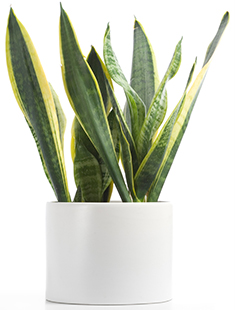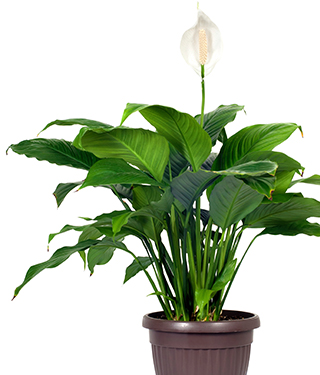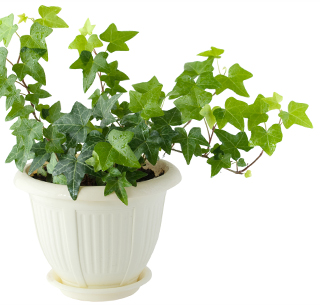
The Best Indoor Plant for You (And How to Take Care of It): Part 3
Clean the air you breathe with the help of a houseplant! In the third of our five-part series, learn about NASA-approved plants that are chlorophyll-caped superheroes disguised as little ol' potted plants.
The air in our homes is polluted. Off-gassing from furniture and carpets releases toxins, while cleaning products and dry-cleaning bring in unexpected pollutants.
But the news isn’t all bad! NASA’s two year study in the late 1980s revealed top-performing houseplants that filter and purify air in closed spaces.
WHAT’S POLLUTING YOUR HOME
The smell of formaldehyde may recall memories of dissection day in biology 101, but it’s found in nearly all indoor environments. Insulation foam, paper products, household cleaners, furniture and carpet backing all release formaldehyde into the air as an odorless gas.
Three volatile organic compounds (VOCs) are also commonly found in home: benzene, trichloroethylene and xylene.
Benzene is used to manufacture detergents, pharmaceuticals and dyes. Trichloroethylene is found mostly in dry-cleaning. Xylene is released by paints and lacquers.
Prolonged exposure to VOCs can increase chances for headaches, liver and lung damage, skin and eye irritation and cancer.
SNAKE PLANT (Sansevieria laurentii)
The snake plant, a.k.a. “Mother-in-Law’s Tongue,” removes all four toxins from closed spaces.

The most common variety, laurentii, is mottled green with a bright yellow outline. Other varieties range in color from sage to darkest green.
The snake plant also releases oxygen at night, something most plants do during the day. Place a snake plant in your bedroom for extra-clean air while you sleep.
How to take care of it: Snake plants will thrive in a wide variety of light conditions: from full-sun to shade to low levels of artificial light.
They’d easily make the Easy-Care/Hard-to-Kill list of houseplants because snake plants thrive with what basically amounts to severe plant neglect.
Always allow the soil dry out before watering. In the winter, water sparingly—as little as every few months or when the leaves begin to shrivel.
Snake plants store water in their upright, sword-shaped leaves, easily withstanding long dry periods. About the only way to kill a snake plant is overwatering.
PEACE LILY (Spathiphyllum)
Peace lilies have broad, waxy leaves and white flower-lEnike bracts, called spathes. They are not true lilies from the Liliaceae family, but from afar the spathes slightly resemble calla lilies.
Peace lilies are effective at removing formaldehyde, benzene, trichloroethylene, xylene and ammonia, which is often found in fertilizers, floor waxes and window cleaners.

How to take care of it: Peace lilies are one of the few indoor plants that actually prefer shade. In winter, a slightly sunnier location with medium to low light is appreciated, but not necessary.
Peace lilies’ tolerance of low light make them a great option for locations with limited natural light, like bathrooms.
This is another plant that would happily reside on the Easy-Care/Hard-to-Kill list. The peace lily is very drought tolerant and can withstand under-watering with no adverse effects.
Your peace lily will tell you when it’s thirsty!
Once the plant has completely dried out, the normally wiry stems will begin to bow and the waxy green leaves will droop. It’ll look positively dog-tired, yet the plant is unharmed.
Water deeply and watch as the stems perk right up while the leaves regain their broad appearance. Overwatering is the most common killer of peace lilies.
ENGLISH IVY (Hedera helix)
There are many different varieties of Hedera helix. Some sport leaves that are deeply-lobed and waxy, others are heart shaped and still others can be yellow, ruffled or cupped.

All varieties are effective filters of all four toxins: formaldehyde, benzene, trichloroethylene and xylene.
English ivy may be the bane of yard and garden architects, and is a noxious weed in Washington State, but inside it provides quite the cleaning power.
How to take care of it: Unlike many houseplants, English ivies thrive in direct sunlight. Try a location that receives at least four hours of direct sunlight per day. Or, choose a brightly lit spot with indirect sun.
Keep the soil moist, but not soggy. Ivies are hardy and can withstand some neglect, but avoid drying out the soil completely.
Pinch back growing tips to encourage a bushier plant. Any cuttings put in water and placed on a windowsill will soon grow roots. If you desire, repot in soil once the roots reach a half-inch long.
GERBERA DAISY (Gerbera jamesonii)
Gerbera daisies, also called Barberton or African daisies, are the only flowering plant on our Top 5 Air-Purifying Plants list.
They’re also non-toxic to cats and dogs, and are the only pet-safe plants to make this list. Check out Part 1 for more pet-friendly plants.
Gerbera jamesonii have deeply lobed leaves and large, colorful blooms in many colors. They’re great filters of trichloroethylene, formaldehyde and xylene.
These plants don’t love to be transplanted, and may not re-bloom. Some people will keep their Gerbera daisy until it stops blooming and then toss it.
How to take care of it: Gerbera daisies are difficult to re-bloom as they won’t produce flowers without intense light, yet the plants hate too much heat.
Any windowsill that provides direct sunlight will often be too hot for this finicky flower. If your plant isn’t overheating, use the most brightly lit location you have.
Keep the soil consistently moist, but water from below using a saucer. Wet leaves can cause problems with mildew and fungal diseases. Good air circulation will discourage disease. Avoid locations with high humidity, like bathrooms.

DRACAENA (Dracaena sp.)
Over 40 species make up the Dracaena genus. The look of each species differs greatly—from mini-trees, to bushy shrubs, to small mounds of pointed fronds.
All varieties of Dracaena are good filters of all four pollutants.
Of the 12 plants NASA studied, four were Dracaenas; Dracaena fragrans “Massangeana,” called fragrant dracaena or corn cane; Dracaena marginata, the red-margined dragon tree; Dracaena deremensis “Warneckei,” a.k.a. striped or Warneckei dracaena; Dracaena deremensis "'Janet Craig," the Janet Craig dracaena.
How to take care of it: Most species of Dracaena can be grown in a similar fashion. Place in bright indirect or curtain-filtered light. The exception is the Warneckei dracaena, which is particularly suited to low light.
Keep the soil moist at all times and encourage new growth by trimming or cutting back the plant.
Check out Part 1, Top 5 Pet-Friendly Plants, for info on another NASA-approved houseplant, the SPIDER PLANT (Chlorophytum comosum).
Part 2, Top 5 Easy-Care/Hard-to-Kill Plants gives the black-thumbed among us a few options.

Next Time: Part 4, Top 5 Classic Houseplants. Three NASA-studied plants make this list too! BOSTON FERN (Nephrolepis exaltata bostoniensis), FICUS (Ficus benjamina) and FLAMINGO LILY (Anthurium scherzeranum).
Find out what makes these go-tos such firm favorites, and how to take care of them.
Keep the good times rollin’! Sign up for emails and get advanced notice on sales, in-store deals, events and more. Plus, catch up on the latest blog posts!
Original article and pictures take www.mclendons.com site
Комментариев нет:
Отправить комментарий